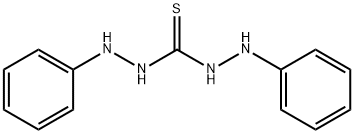Diphenylsilane
- CAS NO.:775-12-2
- Empirical Formula: C12H12Si
- Molecular Weight: 184.31
- MDL number: MFCD00003002
- EINECS: 212-271-4
- SAFETY DATA SHEET (SDS)
- Update Date: 2025-01-27 09:38:02

What is Diphenylsilane?
Chemical properties
clear colorless liquid
The Uses of Diphenylsilane
Thiocarbonyl derivatives of secondary alcohols are readily reduced by diphenylsilane in a radical chain process at room temperature using triethylborane-air as an initiator. An improved radical chain procedure for the deoxygenation of secondary and primary alcohols using diphenylsilane as hydrogen atom donor and triethylborane-air as initiator. Diphenylsilane is a reagent in the invention of radical reactions for deoxygenation of alcohols via their thiocarbonyl derivatives, deamination via isonitriles, and dehalogenation of bromo- and iodo- compounds by radical chain chemistry. Fluorescent film sensor for vapor-phase nitroaromatic explosives via monolayer assembly of oligo(diphenylsilane) on glass plate surfaces. Reductions of carboxylic acid derivatives by silanes in the presence of rhodium complexes were studied. Carboxylic esters were reduced to alcohols by diphenylsilane catalyzed by [RhCl (cod)] 2/4PPh 3 or [RhCl (PPh 3) 3] at room temperature in up to 99% yields. Sequential C- Si bond formations from diphenylsilane and its application to silanediol peptide isostere precursors.
What are the applications of Application
Used in the preparation of silyl-substituted alkylidene complexes of tantalum. Used in the ionic reduction of enones to saturated ketones. Used in the reductive cyclization of unsaturated ketones. Reduces esters in the presence of zinc hydride catalyst. Reduces α-halo ketones in presence of Mo(0). Reduces thio esters to ethers. Reduces esters to alcohols with Rh catalysis. Employed in the asymmetric reduction of methyl ketones and other ketones. Reductively cleaves allyl acetates.
Purification Methods
Dissolve it in Et2O, mix slowly with ice-cold 10% AcOH. The Et2O layer is then shaken with H2O until the washings are neutral to litmus. Dry over Na2SO4, evaporate the Et2O and distil the residual oil under reduced pressure using a Claisen flask with the take-off head modified into a short column. Ph2SiH2 boils at 257o/760mm, but it cannot be distilled at this temperature because exposure to air leads to flashing, decomposition and formation of silica. It is a colourless, odourless oil, miscible with organic solvents but not H2O. A possible impurity is Ph3SiH which has m 43-45o and would be found in the residue. [West & Rochow J Org Chem 18 303 1953, Benkhesser et al. J Am Chem Soc 74 648 1952, Gilman & Zuech J Am Chem Soc 81 5925 1959, Beilstein 16 IV 1366.]
Properties of Diphenylsilane
| Melting point: | <20°C |
| Boiling point: | 95-97 °C/13 mmHg (lit.) |
| Density | 0.993 g/mL at 25 °C (lit.) |
| refractive index | n |
| Flash point: | 209 °F |
| storage temp. | Inert atmosphere,2-8°C |
| form | liquid |
| Specific Gravity | 1 |
| color | colorless |
| Water Solubility | Decomposes in water. |
| Sensitive | Air & Moisture Sensitive |
| Hydrolytic Sensitivity | 3: reacts with aqueous base |
| BRN | 2935887 |
| CAS DataBase Reference | 775-12-2(CAS DataBase Reference) |
| NIST Chemistry Reference | Silane, diphenyl-(775-12-2) |
| EPA Substance Registry System | Silane, diphenyl- (775-12-2) |
Safety information for Diphenylsilane
| Signal word | Warning |
| Pictogram(s) |
 Exclamation Mark Irritant GHS07 |
| GHS Hazard Statements |
H315:Skin corrosion/irritation H319:Serious eye damage/eye irritation |
| Precautionary Statement Codes |
P264:Wash hands thoroughly after handling. P264:Wash skin thouroughly after handling. P280:Wear protective gloves/protective clothing/eye protection/face protection. P302+P352:IF ON SKIN: wash with plenty of soap and water. P305+P351+P338:IF IN EYES: Rinse cautiously with water for several minutes. Remove contact lenses, if present and easy to do. Continuerinsing. P332+P313:IF SKIN irritation occurs: Get medical advice/attention. P337+P313:IF eye irritation persists: Get medical advice/attention. |
Computed Descriptors for Diphenylsilane
| InChIKey | VDCSGNNYCFPWFK-UHFFFAOYSA-N |
New Products
BOC-L-4-HYDROXYPROLINE 2-nitro 3-hydroxy pyridine 2,6-Dichloropyridin-4-amine 2,3 Diamino pyridine 5-Iodo-2-(1-methylethyl)-3(2H)-pyridazinone 1-Azetidinecarboxylic acid, 3-[(3S)-1-(trans-3-carboxy-3-methylcyclobutyl)-3-piperidinyl]-, 1-(1,1-dimethylethyl) ester Tert-Butyl N-[3-(dimethylcarbamoyl)prop-2-en-1-yl]carbamate 1-(difluoromethyl)-N-methylcyclobutan-1-amine 2-(4-Methyl-1,2,5-oxadiazol-3-yl)-1H-benzimidazole 6-(4-iodophenyl)-1-oxa-6-azaspiro[3.3]he Trimethyl(phenylthio)silane Polycaprolactone(2000)-PEG(20000)-Polycaprolactone(2000) Diacrylate Diethylene Glycol Monoethyl Ether, PolyoxyethyleneOleylCetylEtherSulfosuccinate Ascorbyl Tetraisopalmitate or Tetrahexyldecyl Ascorbate Castor Oil, Ethoxylated, Cremophor EL or PEG-35 Castor Oil Tween 20 or Polysorbate 20 Acetone-d6 (R)-2-Mercaptobutanoic acid 3-iodo-1H-pyrazolo[3,4-d]pyrimidin-4-amine 3-(naphthalen-1-ylsulfonyl)-1H-indazol-5-amine methyl 5-amino-3-(1,1-dioxidotetrahydro-2H-1,2-thiazin-2-yl)-2-fluorobenzoate 7-methoxy-8-(2-morpholinoethoxy)-4-((3,4,5-trimethoxyphenyl)amino)benzo[g]quinoline-3-carbonitrile Dimethylaluminum isopropoxideRelated products of tetrahydrofuran








You may like
-
 Diphenylsilane 98% (GC) CAS 775-12-2View Details
Diphenylsilane 98% (GC) CAS 775-12-2View Details
775-12-2 -
 Diphenylsilane 97% CAS 775-12-2View Details
Diphenylsilane 97% CAS 775-12-2View Details
775-12-2 -
 Diphenylsilane CAS 775-12-2View Details
Diphenylsilane CAS 775-12-2View Details
775-12-2 -
 Diphenylsilane CAS 775-12-2View Details
Diphenylsilane CAS 775-12-2View Details
775-12-2 -
 5721-91-5 98%View Details
5721-91-5 98%View Details
5721-91-5 -
 Calcium 11% clear solution 98%View Details
Calcium 11% clear solution 98%View Details -
 Sodium Croscarmellose 98%View Details
Sodium Croscarmellose 98%View Details
74811-65-7 -
 16455-61-1 98%View Details
16455-61-1 98%View Details
16455-61-1
